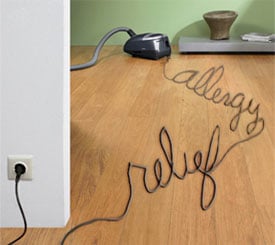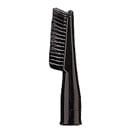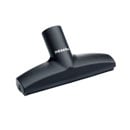 While most people associate vacuuming with carpets, carpets are actually the last thing you should vacuum in your vacuuming routine. Schedule an appointment with Dan Dan The Carpet Man today to refresh and clean your carpets.
While most people associate vacuuming with carpets, carpets are actually the last thing you should vacuum in your vacuuming routine. Schedule an appointment with Dan Dan The Carpet Man today to refresh and clean your carpets.
Regular cleaning of all household surfaces affected by dust is imperative to the health and general well-being of allergy sufferers. But it’s important to know how to clean properly so that the dust doesn’t become airborne and inhaled. Using a quality HEPA vacuum cleaner will help. Learn how to vacuum to reduce allergens in your home below.
Vacuuming Top to Bottom
Start removing dust in your home from the highest levels where dust accumulates and work your way down. Not all of these places may be accessible with your vacuum cleaner, so dusting with an electrostatic or microfiber dust cloth is often a good option. Remember that dusting with a cloth alone or with a traditional feather duster does little to capture dust, but rather stirs it up into the air. When doing any kind of dusting, it’s a good idea to wear an allergy mask in order to minimize inhalation of dust particles.
Vacuuming even seemingly difficult areas is often the best option because it sucks the dust right out of the home environment in one easy sweep. Special universal vacuum attachments for virtually every household dusting task are available. For instance, there are attachments for cleaning ceiling fans and attachments for cleaning mini-blinds – both decidedly inconvenient to clean, and both exceptional dust magnets.
Vacuum cleaner attachments are handy for the entire top-to-bottom routine. Bookshelves and knick-knack shelves are not to be missed; soft brushes or special dusting brushes do the job well. Don’t forget to vacuum draperies too, which can trap and hold dust in its folds, especially if they are heavy drapes. Vacuuming drapes requires less suction than vacuuming many other things, so be sure to lower suction power. (Some recommend shaking drapery to get the dust off and onto the carpet, but this is not the best option for asthma and allergy sufferers because the dust becomes airborne and inhaled. Vacuuming is a better option because the dust goes directly from the drapes into the vacuum bag or canister.)
are handy for the entire top-to-bottom routine. Bookshelves and knick-knack shelves are not to be missed; soft brushes or special dusting brushes do the job well. Don’t forget to vacuum draperies too, which can trap and hold dust in its folds, especially if they are heavy drapes. Vacuuming drapes requires less suction than vacuuming many other things, so be sure to lower suction power. (Some recommend shaking drapery to get the dust off and onto the carpet, but this is not the best option for asthma and allergy sufferers because the dust becomes airborne and inhaled. Vacuuming is a better option because the dust goes directly from the drapes into the vacuum bag or canister.)
Moving downward, don’t forget easily overlooked areas like spaces above cabinets, the tops of picture frames, wainscoting, windowsills, and baseboards. A quick sweep with a brush attachment or crevice tool gets the job done easily and effectively.
 Another major area that needs the vacuum cleaner’s attention is upholstered furniture, which can hold loads of dust and dust mites. Have you ever thumped your sofa cushion on a sunny day and seen what comes up into the air? This, of course, can be helped or even prevented by regular vacuuming of upholstery. (Make sure the attachment you’re using is not dirty from use on the floors when you go to clean your furniture.) Lampshades, particularly textured ones, are also good candidates for vacuuming. In fact, dusting them can push the dirt even further into them.
Another major area that needs the vacuum cleaner’s attention is upholstered furniture, which can hold loads of dust and dust mites. Have you ever thumped your sofa cushion on a sunny day and seen what comes up into the air? This, of course, can be helped or even prevented by regular vacuuming of upholstery. (Make sure the attachment you’re using is not dirty from use on the floors when you go to clean your furniture.) Lampshades, particularly textured ones, are also good candidates for vacuuming. In fact, dusting them can push the dirt even further into them.
Vacuuming, as is now more than clear, isn’t just for carpets. In addition to the above-mentioned items, vacuum areas of your household that don’t have carpeting. For example, the bathroom may have curtains, throw rugs, a shower rod, and possibly even picture frames. All of these places can have a build-up of dust.
Vacuuming Techniques for Eliminating Dust
After tackling the above-the-floor details, it’s finally time to move on to vacuuming the carpet, for which there is another whole set of things to keep in mind.
With all the vacuuming you’re prepared to do, you want to make sure that each round is as effective as possible. Improper vacuuming is not only less beneficial, but it can even cause problems for your carpet and end up making allergies worse. For instance, if you press down on the vacuum cleaner too hard while you vacuum, you will end up crushing the pile. Eventually, this packed-down carpet will not release the dirt that accumulates in it – bad news for those with sensitivities. Here are some things to keep in mind when vacuuming. First, you need to make sure your vacuum cleaner is at its functioning best:
- Check to make sure your vacuum cleaner’s bag isn’t full; if it is, replace it. If your vacuum cleaner is bagless, make sure this isn’t full either. Full bags and bins impact suction and lessen the effectiveness of vacuuming. Note: be careful not to inhale any dust while changing the vacuum bag or emptying the dust bin. Wearing a mask while you change the bag or empty the bin will help ensure that you don’t inhale dust. If possible, empty the dust bin outside.
- Make sure that there isn’t any large debris or hair wrapped around the brush bar of your vacuum cleaner’s motor head. This will not only impact the brush bar’s ability to clean, but could also damage your motor by putting undue stress on it.
- Look for proper attachments that you will need for your particular vacuuming chores of the day. If you’re vacuuming everything – ceiling fans, blinds, upholstery, etc. – make sure that you have all the necessary attachments at hand. You don’t want to break your cleaning momentum to go in search of the tools you need.
Once your vacuum cleaner is ready to go,
-
-
- Remove any large debris that is in your vacuuming path. This will prevent your vacuum cleaner from becoming clogged, losing suction, and overtaxing your vacuum’s motor.
- Don’t forget to do corners and edges with a crevice tool. And don’t forget those baseboards!
 When vacuuming stairs, start with corners and edges using the crevice tool. Sometimes stairs have baseboards too, and these shouldn’t be neglected. Don’t forget to vacuum the vertical part of the stairs as well (a smaller, maneuverable attachment may be required for this). The Eureka Power Paw is a universal attachment that is ideal for use on stairs.
When vacuuming stairs, start with corners and edges using the crevice tool. Sometimes stairs have baseboards too, and these shouldn’t be neglected. Don’t forget to vacuum the vertical part of the stairs as well (a smaller, maneuverable attachment may be required for this). The Eureka Power Paw is a universal attachment that is ideal for use on stairs.- Use slow movements to allow the vacuum cleaner time to use its suction to pull up dust. Slower movement also allows a motorized brush bar sufficient time to pull pet hair out of carpets and upholstery.
- Pass the vacuum cleaner about four times over every area, allowing the vacuum cleaner to collect microscopic particles and allergens.
- Don’t push down on the vacuum cleaner. This causes the carpet’s pile to mat down; a matted carpet doesn’t release dirt
- For an exceptionally thorough job, work the carpet fibers in both directions: if you had gone east to west, go north to south.
- Consider using specially formulated liquid cleaning to trap allergens that cling to carpet fibers. Special powders for killing dust mites are also quite effective. The Ecology Works DustMite and Flea Control, Allersearch X-Mite, and Anti-Allergen Solution work on carpeting and upholstered furniture to kill dust mites and denature other allergens.
-
The Importance of Regular Vacuuming
Many allergens thrive in the home environment, where they can accumulate and become concentrated beyond levels typically found outdoors. Dust is a prime example of this type of allergen. Dust is composed of a variety of material, including dead skin cells, organic fibers from clothing, some amount of soil, dirt, or pollen from the outdoors, and, notoriously, dust mites.
Dust mites love to feast on the components of dust, especially humans’ dead skin cells. Dust mites produce a particular enzyme to digest the components of dust. This enzyme, dust mite feces, and the dust mites’ corpses in turn become parts of dust, and are responsible for much of people’s allergic reactions to dust. Dust mites exist wherever there is dust. They can even be suspended in the air! Dust mites are microscopic and can’t be seen with the naked eye.
Many allergy sufferers have been advised to minimize carpeting in the home. While it’s true that hardwood floors and a smattering of area rugs can minimize the amount of dust that can accumulate unseen for a time, you don’t have to feel guilty if you or your family members suffer from allergies and you still have carpeting. In fact, an interesting perspective is that carpeting actually helps to clear the air by trapping household allergens within its fibers; instead of dust circulating and getting stirred up easily like with hard flooring, the particles are stuck in the carpet waiting to be vacuumed up.
Obviously, this perspective requires diligent, regular, and thorough vacuuming to reduce allergens in your home. Dust can accumulate at a rate of six milligrams per square meter per day. The Association of Home Appliance Manufacturers, or (AHAM), recommends that homeowners adhere to the following vacuuming schedule:
-
-
- Vacuum carpet and rugs at least once a week.
- Vacuum high-traffic areas and bedrooms twice a week.
- Vacuum upholstered furniture, mattresses, and drapes regularly.
- Vacuum even more frequently if you have pets.
-
We recommend that allergy sufferers vacuum their entire home twice a week, if possible. It’s also important to take care to vacuum areas that aren’t seen, as these areas tend to collect dust, and even form dust bunnies. Also notice that carpets are not the only items in your home needing vacuuming. In fact, vacuuming in particular is beneficial in any area that collects dust because it prevents dust from being stirred up.
How to Choose the Right Vacuum Cleaner
When it comes to choosing a vacuum cleaner, there are many factors to consider, especially for asthma and allergy sufferers. Since vacuuming can potentially stir up the dust in your home and make matters even worse, you should definitely consider investing in a high quality vacuum cleaner that is powerful, reliable, and that contains certain important features.
The first of these features is a HEPA filter. HEPA stands for High Efficiency Particulate Air. HEPA filters are 99.97% effective at capturing particles as small as 0.3 microns (a micron is one one-millionth of a meter). A vacuum cleaner equipped with a HEPA filter does an excellent job of trapping minute particles, including pet dander, dust mites, and the other components found in household dust. HEPA filters in allergy vacuum cleaners are important because they prevent dust from being exhausted back into the household.
As the American Academy of Asthma, Allergies & Immunology (AAAAI) states, “Weekly vacuuming can help to further remove dust mites. People with allergies should use a vacuum with a HEPA (high-efficiency particulate) filter or a double bag, since using a standard or water-filtered vacuum cleaner stirs dust up into the air. Allergic individuals should also wear allergy masks.”
 The vacuum cleaner’s style is another matter for consideration. Is your home large or small? Will you have to carry the vacuum cleaner up and down stairs? Do you have only a small space to store it in, or is space not an issue? Answering these questions will help you determine if you need a lightweight vacuum cleaner or if a regular or even heavy duty one is acceptable. Furthermore, these questions will help you decide if you prefer a canister vacuum like the SEBO Air Belt Series or Miele canister vacuum cleaner or an upright vacuum cleaner like most Dysons. You may also want to consider a compact vacuum cleaner like the Miele Delphi C1. If you’re short on space, a stick vacuum works well for small apartments or lofts. Handheld vacuum cleaners like the Dirt Tamer Supreme are also great for quick clean-ups or the car.
The vacuum cleaner’s style is another matter for consideration. Is your home large or small? Will you have to carry the vacuum cleaner up and down stairs? Do you have only a small space to store it in, or is space not an issue? Answering these questions will help you determine if you need a lightweight vacuum cleaner or if a regular or even heavy duty one is acceptable. Furthermore, these questions will help you decide if you prefer a canister vacuum like the SEBO Air Belt Series or Miele canister vacuum cleaner or an upright vacuum cleaner like most Dysons. You may also want to consider a compact vacuum cleaner like the Miele Delphi C1. If you’re short on space, a stick vacuum works well for small apartments or lofts. Handheld vacuum cleaners like the Dirt Tamer Supreme are also great for quick clean-ups or the car.
The next major component to think about is whether you prefer a vacuum cleaner with bags or a bagless vacuum cleaner. Bags have their advantages, especially for allergy sufferers, because they contain the dust and dirt very well so that users don’t have to come in contact with it. However, they are not the most hassle-free and they do require an ongoing expense. Vacuum cleaners that feature a dust bin are quick and easy to empty. But when emptying them it is important to be aware of the dust escaping the bin and to take precautionary measures such as emptying it outside or in another well-ventilated area. Again, as always when dealing with dust, wearing a mask offers significant protection from inhalation.
For a comprehensive selection of vacuum cleaners, see our Vacuum Cleaners page and our Vacuum Cleaner Buying Guide. The Vacuum Cleaner FAQ has some additional useful information.
Regular and thorough vacuuming not only helps allergy sufferers guard against dust-related allergy attacks, but it also helps preserve the life of your carpeting and leaves you with a sparkling clean home you’ll be proud to call your own.
Return to the Allergy Relief Learning Center.
